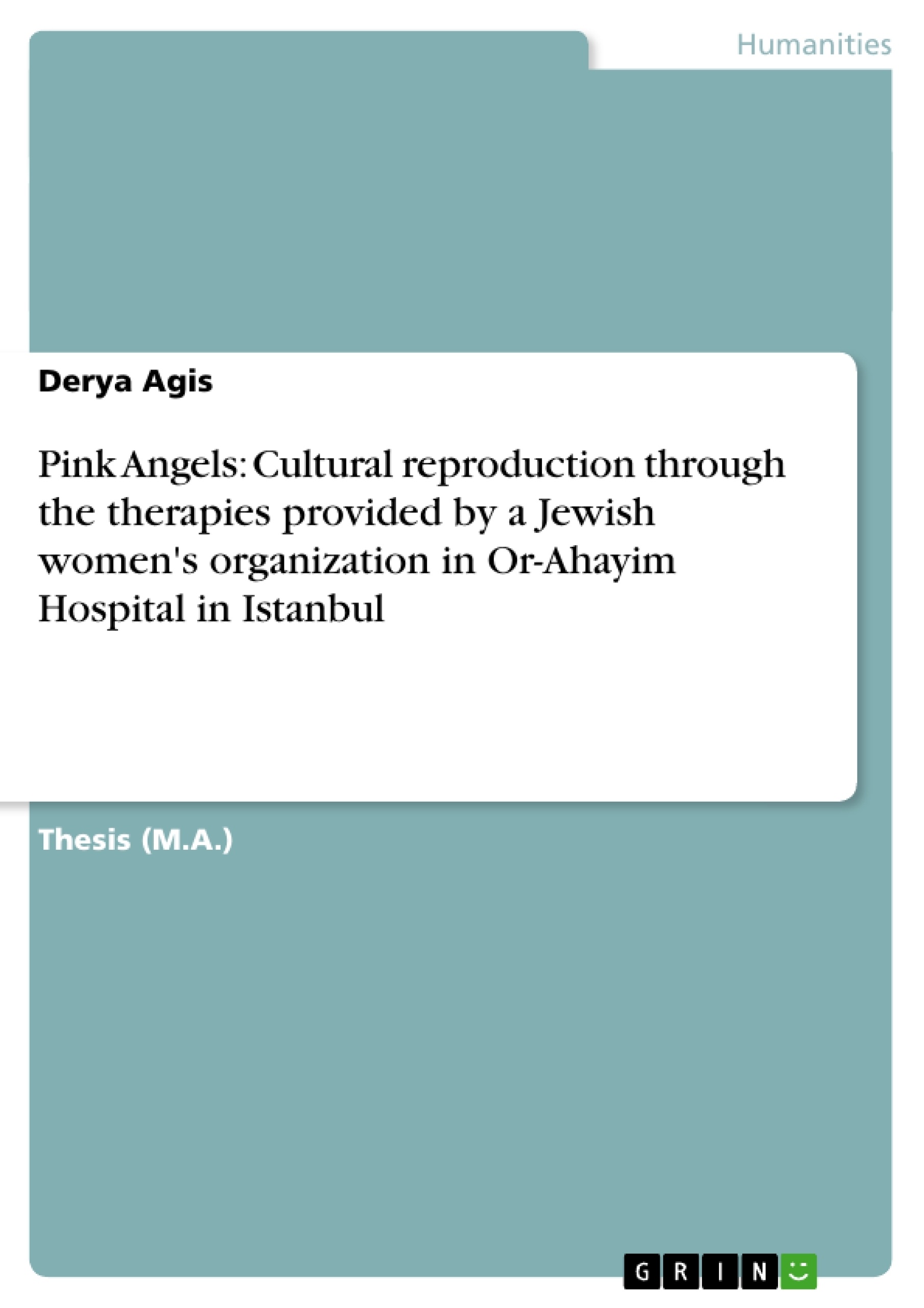Some Turkish Jewish women have been serving the elderly staying in the geriatric unit of the Jewish Or-Ahayim Hospital in Istanbul. Their group is recognized as ‘the Pink Angels.’ The volunteer women at the Jewish hospital founded a group in 1974, and Nuket Antebi named this group ‘the Pink Angels.’ Today this group of women is divided into three subgroups: (1) those who offer chat and art therapies, after having been trained, (2) those who distribute foods and beverages, deal with donations, are involved in the preparation process of jam jars, and offer memorial services, and (3) those who assume both duties. The Pink Angels who serve as therapists contribute to the attainment of world peace locally in Istanbul by chatting and reading various texts belonging to various world cultures in the chat therapies and making the patients create works of art and sing songs related to different cultural occasions in the art therapies by promoting global moral values. Sometimes they promote the moral values of other religious and cultural groups by celebrating different feasts and narrating stories belonging to these diverse groups by underscoring the concept unity in diversity and imposing upon the patients that they constitute a family in the hospital.
Moreover, not only the foods and beverages the Pink Angels distribute, but also the jam jars and gift baskets they prepare carry Turkish Jewish symbols. This thesis based on fieldwork tests the hypotheses that the Pink Angels employ positive symbols in the therapies and activities they conduct, avoid talking about negative issues, such as sadness and death, not only the therapies, but also all the other activities that the Pink Angels conduct evoke happiness and joy in the patients as long as the Turkish Jewish culture is reproduced, since the patients feel as if they were at home, and several intercultural peace building techniques are employed in the therapies together with symbols and metaphorical imagery emphasizing the importance of peace between different religious and ethnic groups by mentioning the commonalities between them, and the rules obeyed by the Pink Angels provide the patients with comfort, since they conceive that they are in a serious and secure place.
Inhaltsverzeichnis (Table of Contents)
- Abstract
- Öz
- Chapter 1: Introduction
- Chapter 2: Methodology
- Chapter 3: The Pink Angels: A Profile
- Chapter 4: The Pink Angels’ Therapies
- Chapter 5: The Pink Angels’ Activities
- Chapter 6: The Pink Angels’ Symbolic Universe
- Chapter 7: The Intercultural Peace Building Dimension
- Chapter 8: Conclusion
Zielsetzung und Themenschwerpunkte (Objectives and Key Themes)
This thesis analyzes the cultural reproduction efforts of the Pink Angels, a group of Turkish Jewish women who provide therapies and activities to elderly patients at the Jewish Or-Ahayim Hospital in Istanbul. The study explores how the Pink Angels utilize various cultural elements, symbols, and interactions to promote a sense of belonging, well-being, and cultural continuity among the patients. The key themes explored in this thesis include:- Cultural Reproduction
- Symbolic Interactionism
- Intercultural Peace Building
- Turkish Jewish Culture
- The Role of Therapies and Activities in Promoting Well-being
Zusammenfassung der Kapitel (Chapter Summaries)
- Chapter 1: Introduction introduces the Pink Angels and their work at the Or-Ahayim Hospital. It outlines the research problem, the objectives, and the theoretical framework of the study.
- Chapter 2: Methodology discusses the research methods employed in this study, including fieldwork, participant observation, and interviews.
- Chapter 3: The Pink Angels: A Profile provides a detailed account of the history, organization, and activities of the Pink Angels.
- Chapter 4: The Pink Angels’ Therapies examines the various therapies provided by the Pink Angels, such as chat and art therapies, and their impact on the patients.
- Chapter 5: The Pink Angels’ Activities focuses on the other activities undertaken by the Pink Angels, including food distribution, donation management, and jam-making.
- Chapter 6: The Pink Angels’ Symbolic Universe analyzes the symbols and metaphorical imagery utilized by the Pink Angels in their therapies and activities.
- Chapter 7: The Intercultural Peace Building Dimension explores the techniques employed by the Pink Angels to promote intercultural understanding and peace among the patients.
Schlüsselwörter (Keywords)
This thesis focuses on the cultural reproduction practices of the Pink Angels, a group of Turkish Jewish women providing therapies and activities to elderly patients at the Or-Ahayim Hospital in Istanbul. It examines the cultural elements, symbolic interactionism, intercultural peace building, Turkish Jewish culture, and the role of therapies and activities in promoting well-being within this context. Key terms include Pink Angels, symbolic interactionism, Turkish Jewish culture, Or-Ahayim Hospital, and cultural reproduction.- Arbeit zitieren
- Derya Agis (Autor:in), 2012, Pink Angels: Cultural reproduction through the therapies provided by a Jewish women's organization in Or-Ahayim Hospital in Istanbul, München, GRIN Verlag, https://www.grin.com/document/206390



